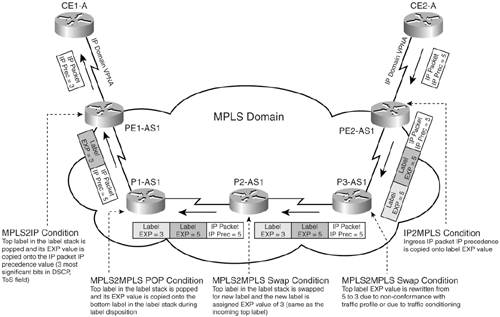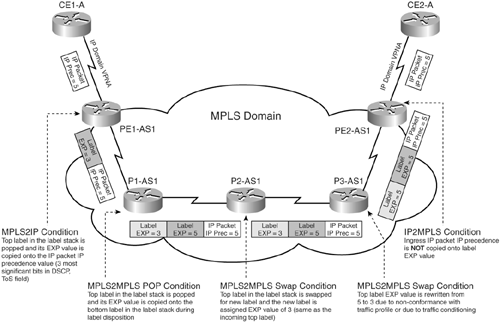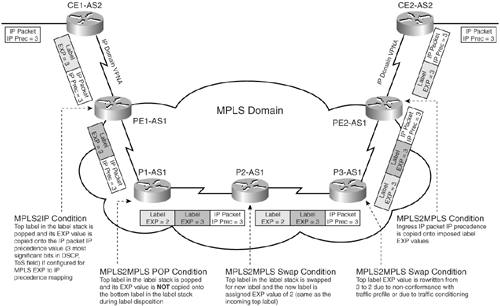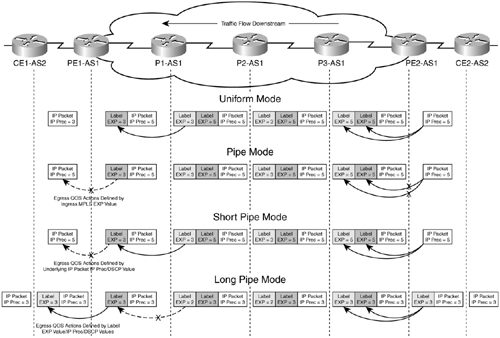MPLS QoS Operating Modes
Multiple modes of operation can exist when implementing QoS using MPLS. These are called the MPLS QoS tunnel modes of operation. The main tunneling modes in the MPLS QoS implementation are
- Uniform mode
- Pipe mode
- Short Pipe mode
- Long Pipe mode
Uniform Mode
In Uniform mode, all changes made to the class of a packet, IP Precedence, DSCP, MPLS EXP values, as the packet traverses the SP infrastructure is maintained as the packet is propagated downstream. The IP packet's IP Precedence value is copied onto the imposed label EXP value when the packet undergoes an IP2MPLS condition. When the packet undergoes a MPLS2IP condition, the top-most label EXP value (because there is a possibility of a labeled packet having more than one label, essentially a label stack) is copied onto the IP Precedence value of the IP packet.
The most important operation of Uniform mode implementation is in the MPLS2MPLS condition when a label is applied to an already labeled packet. In the MPLS2MPLS condition, when a label is swapped, the new label is given the same EXP value as the top-most received label. In the case of an MPLS2MPLS POP, the MPLS EXP value is copied downward in the label stack (top label to bottom label). The operation of Uniform mode is shown in Figure 13-6.
Figure 13-6. Uniform Tunnel Mode Implementation

Figure 13-6 depicts a simple MPLS VPN network with two PE routers, PE1-AS1 and PE2-AS1, connected to CE routers, CE1-A and CE2-A, providing MPLS VPN services. Uniform mode is used in a managed CE scenario where the SP controls QoS from CE to CE via the MPLS domain. When implementing Uniform mode, an IP packet destined for CE1-A from CE2-A is given a label stack (MPLS VPN label stack), the labels are marked with an EXP value of 5 mapping to the ingress IP packet's IP Precedence on PE2-AS1. In some situations, as in the case of traffic engineering or non-conformance to traffic profile, the EXP value might be rewritten in the LSP path. P3-AS1 performs such a function by reassigning the top label's EXP value from 5 to 3 during the label swapping process. P2-AS1 performs a simple MPLS2MPLS swap function and forwards the labeled packet to P1-AS1 while preserving the EXP value at 3. P1-AS1 removes the top label in the label stack (penultimate hop popping). During this process, the top label's EXP value is copied onto the bottom label (MPLS2MPLS POP condition in Uniform mode). PE1-AS1 receives the labeled packet and rewrites the outgoing IP packets IP precedence to 3 to map to the ingress labeled packet's EXP value. In the Uniform mode of operation, the PEs and CEs function as a single differential services domain as the QoS associated with a packet is carried across the MPLS domain as well as the remote CE's IP domain. Therefore, as mentioned earlier, this procedure is mainly implemented in a managed CE scenario.
Pipe Mode
The working of Pipe mode is similar to the working of Uniform mode except that in the MPLS2IP condition, the EXP value of the top-most label is not copied as the IP Precedence value of the IP packet. This mode is used if the QoS implemented by the SP is required to be independent of the customer's QoS policy. In Pipe mode, the IP Precedence of the underlying IP packet is unchanged. The IP packet IP Precedence is not copied onto the MPLS EXP value in the IP2MPLS condition. The IP packet PHB or QoS implementation on the router as the packet undergoes an MPLS2IP condition is based on the EXP value of the label on the egress LSR. During label disposition, the egress LSR maintains a copy of the EXP value in memory as the qos-group value of the packet. This QoS group value is then used to define the PHB on the egress LSR. Figure 13-7 illustrates the operation of Pipe mode.
Figure 13-7. Pipe Mode Implementation'

In comparison to Uniform mode, when implementing Pipe mode, as shown in Figure 13-7, PE1-AS1 does not copy the ingress label EXP value onto the egress IP packet's IP Precedence value. However, the queuing characteristics of the labeled packet on PE1-AS1 still depend on the ingress label EXP value that is copied onto the qos-group value. This implementation is used when the SP would like to implement the PHB based on the QoS policy implementation in the SP core versus the customer's QoS policy when forwarding data to the attached CE routers. Hence, the QoS PHB of the same packet in the IP and the MPLS domain are independent of one another.
Short Pipe Mode
In Short Pipe mode, the difference occurs on egress from the MPLS to the IP domain (MPLS2IP condition). In Short Pipe mode, the packet's PHB is not associated to the ingress labeled packet's EXP value but only on the underlying IP packet's IP Precedence/DSCP value. The egress LSR does not maintain a copy of the ingress labeled packet's EXP value in the qos-group variable, which can be used to identify the egress PHB of the IP packet. This procedure is implemented when the QoS associated with the packet needs to conform to the customer's QoS policy.
Long Pipe Mode
Long Pipe tunnel mode is a variation of the Pipe tunnel mode; the difference being that, on the PE-CE links, the packets are forwarded using label (or label stack) marking and those links are also part of MPLS QoS domain. The CE router receiving traffic from the MPLS backbone can apply its outbound policy toward the VPN site based on MPLS experimental bits or original DSCP bits. The CE router might also copy EXP values to IP Precedence if required. This model is mainly applicable to the carrier supporting carrier (CSC) architecture, as shown in Figure 13-8.
Figure 13-8. Long Pipe Tunnel Implementation

In Figure 13-8, when a labeled packet is received by CE2-AS2 destined for CE1-AS2, the label is associated with the destination, and the label EXP value is copied as the ingress IP packet's IP Precedence value. When PE2-AS1 receives the ingress labeled packet, the label stack is applied with EXP value equal to the ingress label's EXP value. Note that although P3-AS1 rewrites the top label's EXP value to 2 (from 3) upon label disposition at P1-AS1, this value is not copied back down the label stack. PE1-AS1 performs the MPLS2MPLS label swapping function with direct mapping of EXP bits. On receiving the labeled packet on CE1-AS2, the router can perform PHB based on the ingress labeled packets EXP value or underlying IP packet's IP Precedence value.
Summary of MPLS QoS Modes
Figure 13-9 shows the final summary diagram that illustrates all these MPLS QoS modes.
Figure 13-9. Summary Diagram for Different MPLS QoS Modes

MPLS Overview
- MPLS Overview
- Unicast IP Forwarding in Traditional IP Networks
- Overview of MPLS Forwarding
- MPLS Terminology
- MPLS Control and Data Plane Components
- MPLS Operation
- Special Outgoing Label Types
- Penultimate Hop Popping
- Frame-Mode MPLS
- Cell-Mode MPLS
Basic MPLS Configuration
- Basic MPLS Configuration
- Frame-Mode MPLS Configuration and Verification
- Cell-Mode MPLS over ATM Overview, Configuration, and Verification
- Command Reference
Basic MPLS VPN Overview and Configuration
- Basic MPLS VPN Overview and Configuration
- VPN Categories
- MPLS VPN Architecture and Terminology
- MPLS VPN Routing Model
- MPLS VPN Basic Configuration
- Outbound Route Filters
- Command Reference
PE-CE Routing Protocol-Static and RIP
- PE-CE Routing Protocol-Static and RIP
- Static PE-CE Routing Overview, Configuration, and Verification
- Static PE-CE Routing Command Reference
- RIPv2 PE-CE Routing Overview, Configuration, and Verification
- RIPv1 PE-CE Routing Configuration and Verification
- RIP PE-CE Routing Command Reference
PE-CE Routing Protocol-OSPF and EIGRP
- PE-CE Routing Protocol-OSPF and EIGRP
- OSPF PE-CE Routing Protocol Overview, Configuration and Verification
- EIGRP PE-CE Routing Protocol Overview, Configuration, and Verification
Implementing BGP in MPLS VPNs
- Implementing BGP in MPLS VPNs
- BGP PE-CE Routing Protocol Overview, Configuration, and Verification
- Implementing Route-Reflectors in MPLS VPN Networks
- Case Study-Hub and Spoke MPLS VPN Network Using BGP PE-CE Routing for Sites Using Unique AS Numbers
- Case Study-Hub and Spoke MPLS VPN Network with Sites Using Same AS Numbers
- Command Reference
Inter-Provider VPNs
- Inter-Provider VPNs
- Overview of Inter-Provider VPNs
- Option 1: Inter-Provider VPN Using Back-to-Back VRF Method
- Option 2: Inter-Provider VPNs Using ASBR-to-ASBR Approach
- Option 3: Multi-Hop MP-eBGP Between RR and eBGP Between ASBRs
- Option 4: Non-VPN Transit Provider
- Case Study-Inter-AS Implementing Route-Reflector and BGP Confederation in Provider Networks
- Case Study-Multi-Homed Inter-AS Provider Network
- Command Reference
Carrier Supporting Carriers
- Carrier Supporting Carriers
- Carrier Supporting Carriers Overview
- Deployment Scenarios with CSC Architecture
- CSC Architecture Benefits
- Command Reference
MPLS Traffic Engineering
- MPLS Traffic Engineering
- TE Basics
- MPLS TE Theory
- Constraint-Based Routing and Operation in MPLS TE
- Configuring MPLS TE
- Command Reference
Implementing VPNs with Layer 2 Tunneling Protocol Version 3
- Implementing VPNs with Layer 2 Tunneling Protocol Version 3
- L2TPv3 Overview
- Configuring L2TPv3 Tunnels for Layer 2 VPN
- Configuring L2TPv3 Static Tunnels
- Configuring L2TPv3 Dynamic Tunnels
- Implementing Layer 3 VPNs over L2TPv3 Tunnels
- Command Reference
Any Transport over MPLS (AToM)
- Any Transport over MPLS (AToM)
- Introduction to Layer 2 VPNs
- Implementing AToM for Like to Like Circuits
- L2 VPN-Any to Any Interworking
- Local Switching
- Command Reference
Virtual Private LAN Service (VPLS)
- Virtual Private LAN Service (VPLS)
- VPLS Overview
- VPLS Topology-Single PE or Direct Attachment
- Hierarchical VPLS-Distributed PE Architecture
- Command Reference
Implementing Quality of Service in MPLS Networks
- Implementing Quality of Service in MPLS Networks
- Introduction to QoS-Classification and Marking
- MPLS QoS Implementation
- MPLS QoS Operating Modes
- Modular QoS CLI: Configuration of QoS on Cisco Routers
- Configuration and Implementation of MPLS QoS in Uniform Mode and Short Pipe Mode Operation
- Implementing MPLS QoS for Layer 2 VPN Implementations
- Command Reference
MPLS Features and Case Studies
- MPLS Features and Case Studies
- Case Study 1: Implementing Multicast Support for MPLS VPNs
- Case Study 2: Implementing Multi-VRF CE, VRF Selection Using Source IP Address, VRF Selection Using Policy-Based Routing, NAT and HSRP Support in MPLS VPN, and Multicast VPN Support over Multi-VRF CE
- Case Study 3: Implementing Layer 2 VPNs over Inter-AS Topologies Using Layer 2 VPN Pseudo-Wire Switching
- Case Study 4: Implementing Layer 3 VPNs over Layer 2 VPN Topologies and Providing L2 VPN Redundancy
- Case Study 5: Implementing Dynamic Layer 3 VPNs Using mGRE Tunnels
- Case Study 6: Implementing Class-Based Tunnel Selection with MPLS Traffic Engineering
- Case Study 7: Implementing Hub and Spoke Topologies with OSPF
- Case Study 8: Implementing Hub and Spoke Topologies with EIGRP
- Case Study 9: Implementing VPLS Services with the GSR 12000 Series
- Case Study 10: BGP Site of Origin
- Command Reference
EAN: 2147483647
Pages: 130
- Chapter I e-Search: A Conceptual Framework of Online Consumer Behavior
- Chapter IV How Consumers Think About Interactive Aspects of Web Advertising
- Chapter V Consumer Complaint Behavior in the Online Environment
- Chapter VI Web Site Quality and Usability in E-Commerce
- Chapter IX Extrinsic Plus Intrinsic Human Factors Influencing the Web Usage
